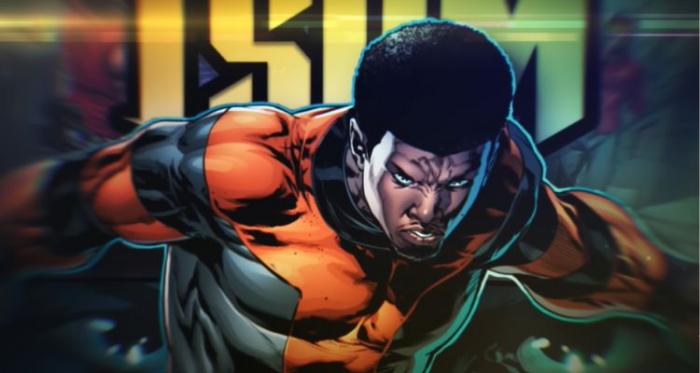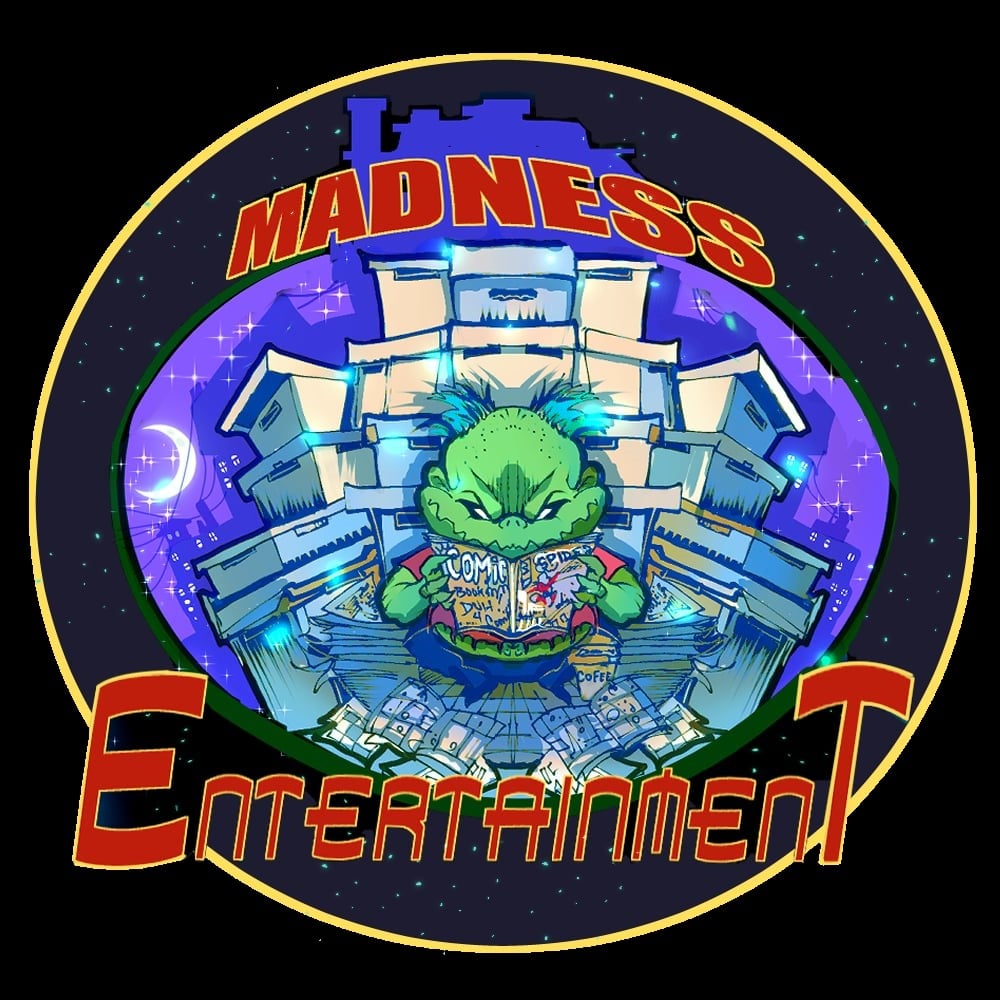ISOM: A Character Who Stands for Nothing
FTC Statement: Reviewers are frequently provided by the publisher/production company with a copy of the material being reviewed.The opinions published are solely those of the respective reviewers and may not reflect the opinions of CriticalBlast.com or its management.
As an Amazon Associate, we earn from qualifying purchases. (This is a legal requirement, as apparently some sites advertise for Amazon for free. Yes, that's sarcasm.)

A few months ago, YouTube influencer Eric D. July, better known by his channel handle Young Rippa, announced his intention to launch his own Rippaverse line of comics- starting with a premiere title ISOM #1. This announcement got a lot of attention, as expected of a man who built a platform with some 500,000 subscribers, and when the campaign launched it was an unprecedented success, clearing millions of dollars within a matter of days and getting a national spotlight of praise and vitriol from both sides of the political debate through exposes on Fox News and the New York Times about the “Anti-Woke” comic book. Between his already booming personality, the exposure boost, and the desire of longtime comic readers to have books with a fresh perspective over the tired tropes of political soapboxing that have so dominated the mainstream industry since the 2010s, Rippa’s promise of building a new universe, and the quick turnaround expected for the project drew me and many others in, and upon receiving my copy a few weeks ago, my thoughts began to brew. However, I struggled with where to begin because contrary to what people may be saying in the echo chambers within this community, Rippaverse’s ISOM #1 is an absolute mess of a book- and worse still is that while July may have succeeded in telling a story free of political soapboxing, he also succeeded in depriving his launch Superhero of any meaning at all.
Rather than address all the problems with this book, as this would take me several dozens of pages, and considering that I imagine that there are many who didn’t make it past my first paragraph, I figured it best to focus this piece on the thing that matters most about this book: its failure to tell us who Isom is, or what he stands for. This problem, in my opinion, supersedes any other failure made in this book as the core of what a superhero is, their mission or goal, is something that should be easily represented, not just in the narrative itself, but in its design. A superhero’s or even supervillain’s design serves as a form of visual storytelling that informs the audience of who they are. It is meant to convey all those things in a striking, bold design that is simple and easily replicated (it is for this reason that many superheroes are designed with masks as it simplifies the human profile and allows for an iconic look unique to that character). However, the first thing that I noticed when looking at even just the campaign of ISOM was, “who is this character, what does he do, why is he a hero,” because none of it comes through in the design philosophy at all. This is made ever more apparent by the fact that no artist drew the character in a way that was consistent across July’s various covers, and none of the versions of the costume we see on the covers match what we see at the book’s end. This leaves a very rocky first impression just visually, and if it were a result of July’s ignorance, that would be bad enough. However, as I will address later, it does not appear to be ignorance at all, but a choice. This brings me to the narrative itself.
The story of Isom focuses on a man named Avery Silman. Now, per the campaign July describes Avery as a person who was once an entry-level hero named Isom in the city of Florespark, Texas. However, a certain event had him give up the suit and live a reclusive life of a rancher. This is where the story begins, with Avery on his farm when he receives a call from his sister to check in on a woman whose mother was a sort of matriarchal figure in Avery’s childhood community. This leads him to confront an old “friend” from college, who was the last person in contact with the missing woman. This confrontation is meant to serve as the books inciting incident back to the costume with the final page being Avery donning his costume once more. However, the story gets confused by failing to really tell us who Avery is. It battles itself with competing narratives that are incongruent with one another and leaves the reader asking “why?” in frustration.
The first of the many faces of Avery Silman is the context we get from July’s pitch, a man who has chosen a life in reclusion over the responsibilities of being a hero. This is initially reinforced by his first interaction with his sister, during which he insists on not getting involved in any trouble, and even the interaction he has with the antagonist in this first story, his friend from college, Darren Fontaino. Darren describes their school experience to us, and what we get is one that, given our knowledge of Avery from the pitch, implies a desire to hide who he was. An all-star athlete who was fine with not getting the spot on the team, an intelligent man who aggressively sought the bare minimum needed to pass his classes. It reminded me a bit of how Geoff Johns wrote the young Clark Kent during Superman: Earth One, a person who was, by all means, exceptional but was doing his very best to hide it so as not to draw the attention of everyone else. All of this falls in line with what was pitched. However, we are then presented with a new face of Avery Silman, a face that cannot stand being talked down to and patronized by this low life. The insult that Avery receives in this book serves as his fuel to keep on the mission. Not to save this woman, but to get Darren back for the disrespect. This actively clashes with the established narrative and confuses Avery’s character while simultaneously making him feel not very heroic at all.
This is not to say that there is no such thing as a hero plagued with a flaw of pride or vanity. I myself am a huge fan of classical characters like Achilles, or even more modern heroes like Booster Gold who suffer from the same. However, their writing is consistent. Achilles is always going to do what he sees is best for him. Booster is always going to try and make fame and fortune off his superhero exploits. Overcoming those proclivities is also possible, but only through the process of organic narrative where the character is put in a position where the only way forward is to come to terms with that flaw and press on. However, in Isom, the initial portrait painted of Avery is of a man who wishes to stay under the radar, is relatively apathetic, and is detached, but the moment an old high school acquaintance says something not so nice, all bets are off. This is not a consistent portrait of this character. A man who has the resolve and reserve to fly under the radar for his whole life doesn’t fly off the handle when he’s insulted, just as a man whose pride doesn’t suffer the criticism of others would not be willing to go unnoticed for his talents. The fact that this pride is what drives him for the rest of the book is even more problematic as it completely undoes what the audience understood of the character at the beginning. This leaves the audience increasingly asking who Avery really is and why did he stop being a hero in the first place.
Neither of those questions ever gets answered of course. July teases us with small nods of dialogue referring to his sister’s late husband and an exposition box letting us know that the scene where Avery decided to not be a hero and return his costume would be given to us in another book. Some seventy pages into this story and the questions that matter about this character that allows an audience to connect and understand the character are still just giant question marks. However, it’s all made exceptionally worse by the final pages where Avery picks up his costume from the Superhero tailor. Earlier in this piece, I mentioned that the failure of Avery’s costume design philosophy was not a result of July’s ignorance, but a matter of choice, and it is here this becomes clear. Upon receiving Avery’s request to have his old costume back, the designer refuses, stating that the costume’s design is dated, and not indicative of the work he does now. The tailor emphasizes that this costume is not just a suit, but an extension of the brand, and proceeds to ask Avery: “What do you want this suit to do?” This question goes to the very criticism of what I stated previously. What do you stand for Avery, what is Isom, what do you want it to mean to people? And with all this weight hanging on this question, Avery replies “resist fall damage,” in reference to him being dropped and rendered unconscious earlier in the book.
July knows the importance of this scene, even if it's just subconsciously, he knows. This is the moment where he defines who his character is, and rather than give his character a raison d’etre, he gives us a non-answer. Avery Silman, Isom, is a man who stands for nothing. Eric D July may have kept his promise to make an “anti-woke” book free of political soapboxing, but in the process, he gave us a character void of any meaningful purpose. He’s an empty shell in a costume. What’s more frustrating still is that I look around and see the praise this is getting with the community, the bland pats on the back, and the “good jobs,” of an echo chamber free from critique. It was my understanding that the whole point of these consumer movements away from Marvel and DC was based on a consumer-led meritocracy. However, how can this be considered genuine if we do not apply the same level of critique that we apply to the books that steered us away from the mainstream? Is it really enough that a book just not lecture its audience on a political message that doesn’t align with our own? By not being honest about this book’s faults, and believe me, there is far more than just how it let down the introduction of its lead character, we devalue the criticisms made of the mainstream. We allow ourselves to be branded hypocrites, and justly so. We deprive July of the means to improve his storytelling, the promise of the Rippaverse could change things, but only if it's faced with the same lens of scrutiny applied to its competitors. The fact is that July’s base will never allow him to fail, even with this review being published I doubt it will affect the earnings on his campaign for his next book negatively. However, it has no chance for growth beyond if we praise mediocrity and do not demand excellence from an IP that garnished almost 4 million dollars in less than a week. To change the industry, Rippaverse needs heroes that at the very least stand for something, and Isom #1 certainly doesn’t fit that bill.


